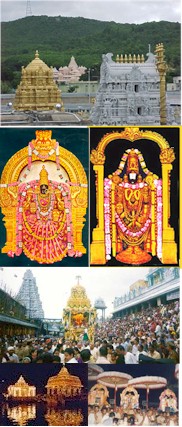Welcome to Adiyen Sri Ramanuja Dasan !
" Srimathe Ramanujaya Namaha !"
Ans .: (94. Q. Contd...) VISHNU SVAROOPAM - Lord Vishnu is to be depicted as a four-armed male-form: The four arms indicate his all-powerful and all-pervasive nature. The physical existence of Vishnu is represented by the two arms in the front while the two arms at the back represent his presence in the spiritual world. The Upanishad titled Gopal Uttartapani describes the four arms of Vishnu.
The color of his skin has to be new-cloud-like-blue: The blue color indicates his all-pervasive nature, blue being the color of the infinite sky as well as the infinite ocean on which he resides.
On his chest is the srivatsa mark, symbolising his consort Lakshmi. It is on the chest of Vishnu, where Lakshmi resides.
Around his neck, he wears the auspicious "Kaustubha" jewel, and a garland of flowers (vanamaalaa). It is in this jewel, on Vishnu's chest that Lakshmi dwells.
A crown should adorn his head: The crown symbolizes his supreme authority.
He is to shown wearing two earrings: The earrings represent inherent opposites in creation - knowledge and ignorance; happiness and unhappiness; pleasure and pain.
He rests on Ananta: the immortal and infinite snake .
The Vishnu Purana is often considered to be the most important of all the eighteen Puranas and is given the name Puranaratna (gem of Puranas).Presented as a dialogue between Parashara with his disciple Maitreya. It is divided into six parts. The major topics discussed.
Mostly there were stories of Lord Rama and Krishna in this Puranam.
The book starts with detailed stories of creation and introduces the concept of four yugas. The tale of Rudra, an elaborate story of the Samudra Manthana, or the churning of the ocean, the Story of Dhruva, an ardent devotee of Vishnu, and stories of ancient kings Vena and Prithu are also discussed in the first section. Tales of Prithu's descendants, the Prachetas, the famous story of Hiranyakashipu and Prahlada, some topological details of the known world with mentions of lands, tribes, mountains and rivers, concepts of the universe, and the stories of the many births of Jadabharata are the major topics discussed in the next book. The third section discusses the stories of Manvantara (cycles of creation and destruction), the sages Vyasa and Yajnavalkya, Surya (the sun god),Yama (the god of the dead), devotees Shatadhanu and Shaivya, the four classes (varnas) and the four stages of life(ashramas) and details of many rituals. The fourth section gives a detailed account of all the famous Kings from the solar and lunar dynasties of ancient India, and also lists the names of kings who 'would appear' in the age of Kali. The second list contains the name of historical kings of Magadha, including kings from the Shishunaga, Nanda and Maurya dynasties.
The next section deals in details the different events in the life of Lord Krishna, starting from his birth, through his childhood and up to his death and the destruction of the entire Yadava clan. The sixth and last section mainly discusses the impending age of Kali, the concepts of universal destruction that would eventually follow and explains the importance of the Puranas in general.
The Bhagavata Purana (also known as Śrīmad Bhagavatam, or simply Bhagavatam) is one of the Puranic texts of Hindu literature. Its primary focus is the process of bhakti yoga (loving devotion to the Supreme Lord) in which Vishnu and/or Krishna is understood as the Supreme all-embracing God of all gods (Bhagavan).
Jai Srimannaryana !
Thanks for your valuable time. Visit our web site again for more information and latest updates.

